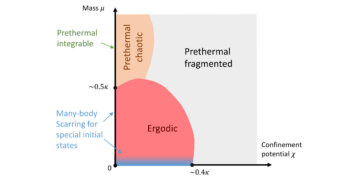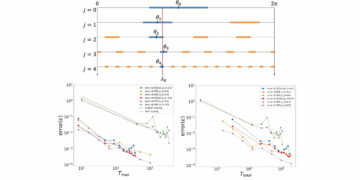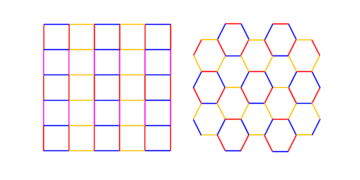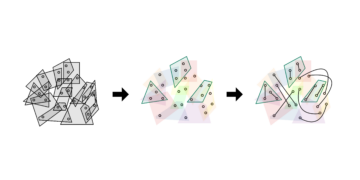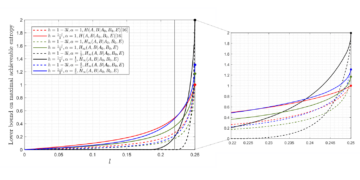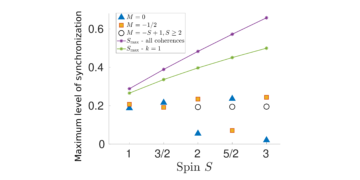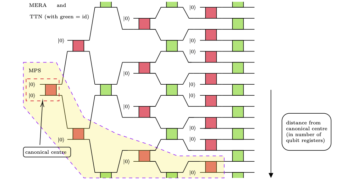
1Department of Mathematical Sciences, University of Copenhagen, 2100 Copenhagen, Denmark
2Institut Camille Jordan, Université Claude Bernard Lyon 1, 43 Boulevard du 11 Novembre 1918, 69622 Villeurbanne cedex, France
3Laboratoire de Physique Théorique, Université de Toulouse, CNRS, UPS, France
4Institute for Theoretical Physics, Leibniz Universität Hannover, 30167 Hannover, Germany
5Bosch Center for Artificial Intelligence, Robert-Bosch-Campus 1, 71272 Renningen, Germany
Find this paper interesting or want to discuss? Scite or leave a comment on SciRate.
Abstract
In his solution of Hilbert’s 17th problem Artin showed that any positive definite polynomial in several variables can be written as the quotient of two sums of squares. Later Reznick showed that the denominator in Artin’s result can always be chosen as an $N$-th power of the squared norm of the variables and gave explicit bounds on $N$. By using concepts from quantum information theory (such as partial traces, optimal cloning maps, and an identity due to Chiribella) we give simpler proofs and minor improvements of both real and complex versions of this result. Moreover, we discuss constructions of Hilbert identities using Gaussian integrals and we review an elementary method to construct complex spherical designs. Finally, we apply our results to give improved bounds for exponential quantum de Finetti theorems in the real and in the complex setting.
► BibTeX data
► References
[1] Emil Artin. Über die Zerlegung definiter Funktionen in Quadrate. In Abhandlungen aus dem mathematischen Seminar der Universität Hamburg, volume 5, pages 100–115. Springer, 1927.
[2] Jacek Bochnak, Michel Coste, and Marie-Françoise Roy. Real algebraic geometry, volume 36. Springer Science & Business Media, 2013.
[3] Rajendra Bhatia. Matrix analysis, volume 169. Springer Science & Business Media, 1997.
[4] Giulio Chiribella. On quantum estimation, quantum cloning and finite quantum de finetti theorems. In Conference on Quantum Computation, Communication, and Cryptography, pages 9–25. Springer, 2010.
[5] Philippe Delsarte, Jean-Marie Goethals, and Johan Jacob Seidel. Spherical codes and designs. In Geometry and Combinatorics, pages 68–93. Elsevier, 1991.
[6] Andrew C Doherty and Stephanie Wehner. Convergence of sdp hierarchies for polynomial optimization on the hypersphere. arXiv preprint arXiv:1210.5048, 2012.
arXiv:1210.5048
[7] William J Ellison. Waring’s problem. The American Mathematical Monthly, 78(1):10–36, 1971.
[8] Leonid Faybusovich. Global optimization of homogeneous polynomials on the simplex and on the sphere. In Frontiers in global optimization, pages 109–121. Springer, 2004.
[9] Kun Fang and Hamza Fawzi. The sum-of-squares hierarchy on the sphere and applications in quantum information theory. Mathematical Programming, pages 1–30, 2020.
[10] Ronald L Graham, Donald E Knuth, and Oren Patashnik. Concrete Mathematics, 2nd Edition. Massachusetts: Addison-Wesley, 1994.
[11] Aram W Harrow. The church of the symmetric subspace. arXiv preprint arXiv:1308.6595, 2013.
arXiv:1308.6595
[12] Felix Hausdorff. Zur Hilbertschen Lösung des Waringschen Problems. Mathematische Annalen, 67(3):301–305, 1909.
[13] David Hilbert. Beweis für die Darstellbarkeit der ganzen Zahlen durch eine feste Anzahl n-ter Potenzen (Waringsches Problem). Mathematische Annalen, 67(3):281–300, 1909.
[14] Ernest W Hobson. The theory of spherical and ellipsoidal harmonics. CUP Archive, 1931.
[15] Kôdi Husimi. Some formal properties of the density matrix. Proceedings of the Physico-Mathematical Society of Japan. 3rd Series, 22(4):264–314, 1940.
[16] Leon Isserlis. On a formula for the product-moment coefficient of any order of a normal frequency distribution in any number of variables. Biometrika, 12(1/2):134–139, 1918.
[17] Robert König and Graeme Mitchison. A most compendious and facile quantum de finetti theorem. Journal of Mathematical Physics, 50(1):012105, 2009.
[18] Jean-Louis Krivine. Anneaux préordonnés. Journal d’analyse mathématique, 12(1):307–326, 1964.
[19] Michael Keyl and Reinhard F Werner. Optimal cloning of pure states, testing single clones. Journal of Mathematical Physics, 40(7):3283–3299, 1999.
[20] Murray Marshall. Positive polynomials and sums of squares. Number 146. American Mathematical Soc., 2008.
[21] Mok Hoi Nam. Effective aspects of positive semi-definite real and complex polynomials. Master’s thesis, Department of Mathematics, National University of Singapore, 2008.
[22] Yu V Nesterenko. On Waring’s problem (elementary methods). Journal of Mathematical Sciences, 137(2):4699–4715, 2006.
[23] Mihai Putinar. Positive polynomials on compact semi-algebraic sets. Indiana University Mathematics Journal, 42(3):969–984, 1993.
[24] Daniel G Quillen. On the representation of hermitian forms as sums of squares. Inventiones mathematicae, 5(4):237–242, 1968.
[25] Renato Renner. Symmetry of large physical systems implies independence of subsystems. Nature Physics, 3(9):645, 2007.
[26] Bruce Reznick. Uniform denominators in Hilbert’s seventeenth problem. Math. Z., 220(1):75–97, 1995.
[27] Konrad Schmüdgen. The K-moment problem for compact semi-algebraic sets. Mathematische Annalen, 289(1):203–206, 1991.
[28] Andrew J Scott. Tight informationally complete quantum measurements. Journal of Physics A: Mathematical and General, 39(43):13507, 2006.
[29] Gilbert Stengle. A Nullstellensatz and a Positivstellensatz in semialgebraic geometry. Mathematische Annalen, 207(2):87–97, 1974.
[30] Gabor Szegö. Orthogonal polynomials, volume 23. American Mathematical Soc., 1939.
[31] Wing-Keung To and Sai-Kee Yeung. Effective isometric embeddings for certain Hermitian holomorphic line bundles. Journal of the London Mathematical Society, 73(3):607–624, 2006.
[32] Mark M Wilde. Quantum information theory. Cambridge University Press, 2017.
Cited by
Could not fetch Crossref cited-by data during last attempt 2023-05-12 10:41:23: Could not fetch cited-by data for 10.22331/q-2023-05-12-1001 from Crossref. This is normal if the DOI was registered recently. On SAO/NASA ADS no data on citing works was found (last attempt 2023-05-12 10:41:23).
This Paper is published in Quantum under the Creative Commons Attribution 4.0 International (CC BY 4.0) license. Copyright remains with the original copyright holders such as the authors or their institutions.
- SEO Powered Content & PR Distribution. Get Amplified Today.
- PlatoAiStream. Web3 Data Intelligence. Knowledge Amplified. Access Here.
- Minting the Future w Adryenn Ashley. Access Here.
- Buy and Sell Shares in PRE-IPO Companies with PREIPO®. Access Here.
- Source: https://quantum-journal.org/papers/q-2023-05-12-1001/
- :is
- :not
- 1
- 10
- 11
- 12
- 13
- 14
- 15%
- 1994
- 1999
- 20
- 2012
- 2013
- 2017
- 2020
- 22
- 23
- 24
- 26
- 27
- 28
- 30
- 3rd
- 7
- 8
- 9
- a
- ABSTRACT
- access
- affiliations
- Alexander
- always
- American
- an
- analyse
- analysis
- and
- Andrew
- any
- applications
- Apply
- Archive
- artificial
- artificial intelligence
- AS
- aspects
- author
- authors
- BE
- both
- Break
- Bruce
- bundles
- business
- by
- cambridge
- CAN
- Center
- certain
- chosen
- church
- Codes
- comment
- Commons
- Communication
- complete
- complex
- computation
- concepts
- Conference
- construct
- Convergence
- Copenhagen
- copyright
- could
- cryptography
- Cup
- Daniel
- data
- David
- Den
- density
- Department
- designs
- Die
- discuss
- distribution
- donald
- due
- during
- e
- edition
- Effective
- Ellison
- emil
- Ether (ETH)
- exponential
- Finally
- For
- formal
- forms
- formula
- found
- Frequency
- from
- Frontiers
- gave
- General
- geometry
- gilbert
- Give
- Global
- harvard
- hierarchy
- his
- holders
- HTTPS
- identities
- Identity
- if
- improved
- improvements
- in
- independence
- Indiana
- information
- institutions
- Intelligence
- interesting
- International
- Japan
- JavaScript
- Jordan
- journal
- König
- large
- Last
- later
- Leave
- License
- Line
- London
- Lyon
- Maps
- mark
- massachusetts
- master
- math
- mathematical
- mathematics
- Matrix
- May..
- measurements
- Media
- method
- methods
- Michael
- minor
- Month
- monthly
- Moreover
- most
- Murray
- Nam
- National
- Nature
- no
- normal
- number
- of
- on
- open
- optimal
- optimization
- or
- order
- original
- our
- Paper
- Philippe
- physical
- Physics
- plato
- Plato Data Intelligence
- PlatoData
- positive
- power
- press
- Problem
- problems
- Proceedings
- Programming
- proofs
- properties
- published
- publisher
- Quantum
- quantum information
- quotient
- real
- recently
- references
- registered
- remains
- representation
- result
- Results
- review
- ROBERT
- roy
- s
- Science
- SCIENCES
- SDP
- seminar
- Series
- Sets
- setting
- several
- showed
- Simplex
- Singapore
- single
- Society
- solution
- some
- Squared
- squares
- States
- such
- sums
- Systems
- Testing
- that
- The
- their
- theoretical
- theory
- thesis
- this
- Title
- to
- two
- under
- university
- UPS
- URL
- using
- variables
- volume
- W
- want
- was
- we
- with
- works
- written
- year
- zephyrnet

